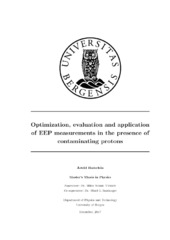| dc.description.abstract | It is well known that energetic particles can penetrate deep into the atmosphere and initiate a chain of chemical reactions, ultimately leading to enhanced production rates of HOx and NOx molecules and the depletion of local ozone abundances. This, in turn, alters Earth’s radiation balance and might influence winter climate. In recent years, numerous studies have been conducted in order to examine the extent of ozone depletion due to precipitation of energetic protons during solar proton events (SPEs), which is mostly restricted to polar cap regions. The significance of a second source of energetic particles during these events, namely energetic electron precipitation (EEP) originating from the outer radiation belt, has however not been established yet. A key element regarding the necessary investigations is to obtain an estimate on the incoming electron flux from the MEPED detectors on board the NOAA POES satellites. Previous efforts have faced various obstacles including detector degradation and cross contamination. In order to correct the measured electron flux for falsely measured protons, the contaminating proton flux is determined and subtracted. During this process, statistical uncertainties arise making it necessary to test the remaining electron flux for significance. The three objectives of this study are motivated by the community's lack of success in disentangling the EEP contribution, in particular during SPEs. Firstly, a novel criterion for the statistical significance of corrected electron fluxes is presented and implemented in order to improve the POES MEPED losscone dataset. Improvements resulting from the new criterion and general limits set by proton contamination and other technical issues are discussed. By applying a newly developed analysis technique, the losscone fluxes are estimated. Secondly, the improved losscone dataset is compared to the Ap-based EEP flux parametrization used in CMIP6. The modelled fluxes are tested with respect to their ability to reproduce general flux levels as well as temporal and spatial variability. The third aim of this work is to investigate the applicability of corrected electron fluxes measured by the MEPED instrument during periods of high contamination. Therefore, six SPEs are investigated with the aim to establish the degree of data rejection and data coverage throughout the events. Even after introducing a less strict contamination criterion, data rejection is high in regions of large proton fluxes. Low latitudes and MLTs corresponding to the post-midnight and morning sector, however, show promising data coverage and are used to determine whether SPE electron fluxes behave identically to regular storm fluxes defined by similar geomagnetic indices. | en_US |
